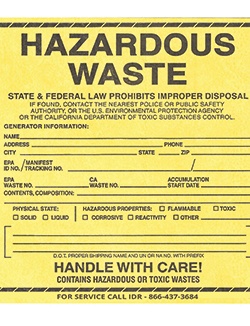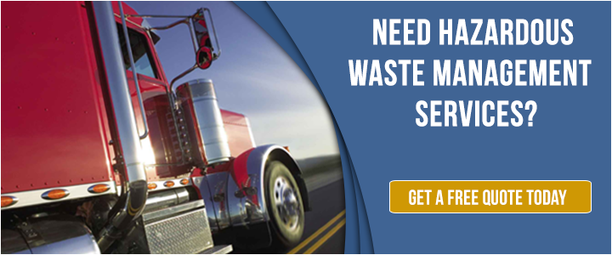Anytime hazardous waste materials are prepared for shipping, companies must follow a series of regulatory precautions.
Unfortunately, not all generators do this or are aware of the Department of Transportation’s regulations. This can lead to costly fines.
Federal regulations apply to every drum of resin or a transference of hazardous material from one place to another. Generators always must abide by the regulations set forth by the DOT. Below, we’ll look into some of the regulatory policies set forth by the DOT, and provide a few resources that will help you ensure your business is meeting all regulations.
Hazardous Material Manifests
 Of all the major responsibilities of hazardous material shippers, identification of what you’re shipping is one of the most important - if not the most important - responsibility.
Of all the major responsibilities of hazardous material shippers, identification of what you’re shipping is one of the most important - if not the most important - responsibility.
According to Federal Motor Carrier Safety Administration (FMCSA), general shipper responsibilities are outlined in 49 CFR Part 173. These current regulations are consistent with international requirements, though there are some differences when shipping to and from Canada. These regulations can be found in CFR sections 171.12 and 171.22.
As part of the identification process, shipping manifests are required. The process by which manifests are submitted has changed over the past few years, however, and it’s important to be up-to-date on what is required now.
In 2018, the Environmental Protection Agency began implementing a national e-manifest system that tracks hazardous waste shipments electronically. For several decades, the EPA imposed a manifest system that tracks cradle-to-grave hazardous waste.
Recently, however, the manifest system changed to an electronic format to save time, resources and costs. The database runs through the EPA’s Resource Conservation and Recovery Act (RCRA) info website.
Though the e-manifest system allows generators and transporters to create, edit and sign manifests, much of the same information that was required on paper versions is also required in the electronic format. Examples of information found on a manifest include:
- Both the shipper and consignee’s name and address
- A basic description of the material, including the name, hazard class, ID number and packing group
- Weights and volumes of the substance
- Emergency response information, including a 24-hour response phone number
- The shipper’s declaration that the packaging meets DOT standards
- A manifest tracking number
- Signatures of both the generator and transporter
Any hazardous waste transporter you use in California must also be registered with the Department of Toxic Substances Control (DTSC). California requires that ID numbers for all parties involved with the transportation of hazardous waste be included on the manifests.
Hazardous Waste Labels
The DOT requires hazardous waste generators to label and mark each package of waste before transporting off site. This involves placing a placard on the waste container, or offering placards to the initial transporter.
For shipments of hazardous material and wastes, the DOT requires each non-bulk package (maximum capacity no more than 119 gallons) to display, at a minimum:
- The proper shipping name and identification of the hazardous material
- The name and address of the shipper and/or the designated recipient
- The diamond hazard labels for the primary (and most subsidiary) hazard classes of the hazardous material
The DOT also requires that labels be properly placed on the container so that they are not missed by handlers. The labels must appear in their entirety and should not be placed near any other markings on the surface. To avoid being missed, never place labels near the bottom of a container.
The California Department of Toxic Substances Control (DTSC) also provides its own set of requirements that hazardous waste generators must follow when it comes to proper labeling. This includes labeling each portable tank with the following information:
- Composition and physical state of the waste
- Statement that calls attention to the hazardous properties of the waste
- Name and address of the generator
Our article, Hazardous Waste Label Requirements You Need To Know, further outlines labeling requirements when packaging hazardous waste for transport.
Emergency Response And Security
 As mentioned above, any person who provides a hazardous material for transportation must provide an emergency response number, including the area code or international access code.
As mentioned above, any person who provides a hazardous material for transportation must provide an emergency response number, including the area code or international access code.
This is in case an emergency involving the hazardous material occurs. This contact information must be accessible 24 hours a day and must be included on the manifest.
DOT regulations also require that a security plan be in place, as well as offer security training to hazmat employees. This training must include an awareness of security risks associated with transporting hazardous waste, as well as information about the security plan.
Your plan must include an assessment of possible transportation security risks, as well as a plan for responding to the risks listed. These transportation security plans should remain in effect as long as they continue to be relevant.
Resources
Proper compliance with regulations is essential to maintaining a safe workplace and following cradle-to-grave requirements with transporting hazardous waste.
California’s Department of Toxic Substances Control site offers information about packaging and transporting hazardous waste, and the Federal Motor Carrier Safety Administration site provides detailed information about shipper and carriers’ responsibilities in regards to meeting regulations.
A properly licensed and experienced hazardous waste company also can be a valuable resource for your business. Not only will one make sure your paperwork is properly filled out, a licensed hazardous waste company also will handle the waste for you and make sure you meet all regulations for transport.
Working with a hazardous waste company also can be an economical choice, since using a certified company can free employees from the time-consuming responsibilities and requirements when dealing with hazardous waste management.


Comment